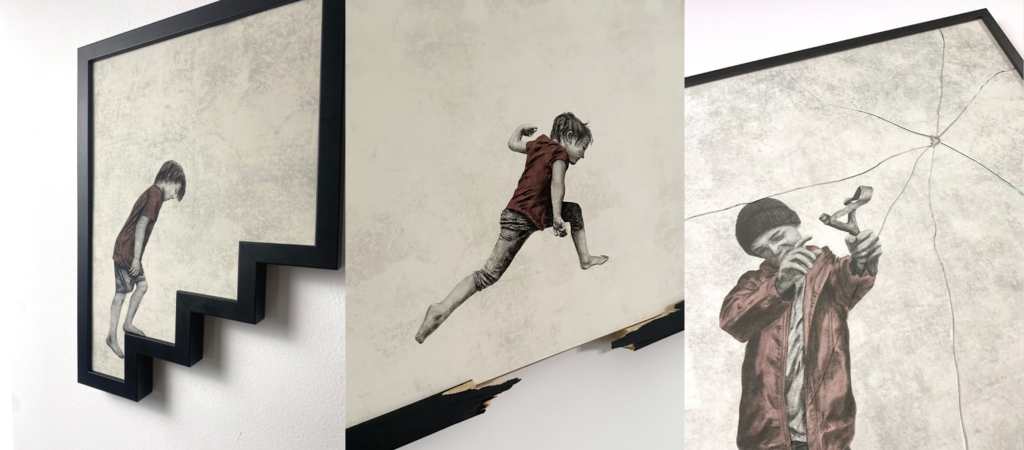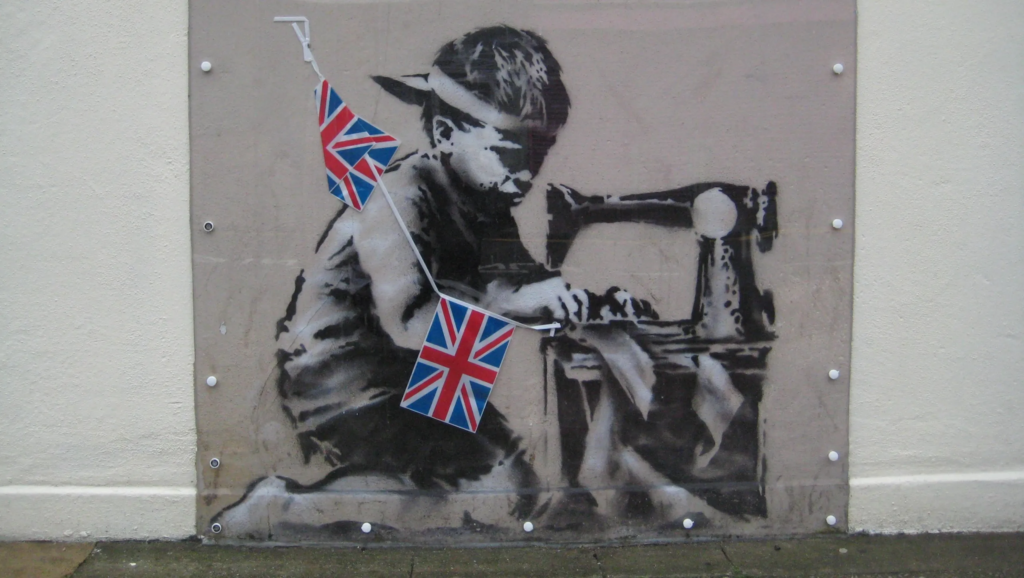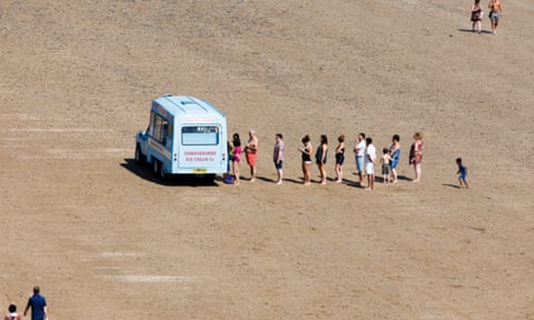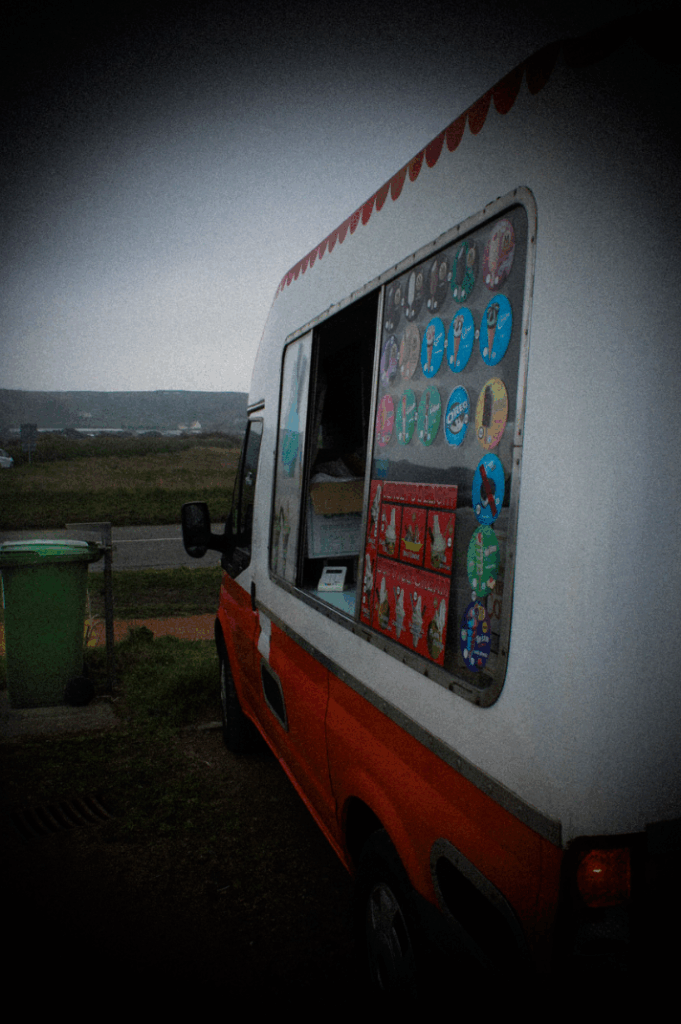Andrew Scott
For my first artist reference, I went for Andrew Scott. He was firstly born in 1991 and was best known for as an artist that makes his art look realistic, because he uses effects such as breaking the glass on the frame to match the drawing/adds actual objects like a popped balloon for an art piece he did which was a little girl looking sad holding the string to the balloon.

In these images, you can see how the art piece he creates, interacts with the frames like the first one with the young boy climbing up the frame, (as stairs), which Scott has created by cutting and changing the physical shape of the frame.
In the middle image, you can see the young boy leaping over nothing, (before the frame is put on). But, after Scott has broken the frame in the middle underneath the boy jumping, it creates a realistic feel to the viewer as now the boy is jumping/leaping over the actual frame.
In the third image, he created this young boy shooting a slingshot just to his right, but in reality there isn’t any damage until Scott changes his frame/glass over the image to help add effect and emotion to the original image, such as using a nail and hammer and creating a smashed hole in the glass frame, to create a view of the young boy in the frame shot his slingshot at the frame and it smashed it. They are all very interictal with the viewers as they create a funny/realistic approach.
Through Andrew Scott’s art work, he experiments a lot whether it’s through breaking, shattering, burning, or reconfiguring frames, but Andrew brings the subjects in his artwork to life. By breaking the fourth wall and making the frame part of the artwork itself, Andrew continually bends artistic convention in new and surprising ways.
Banksy
For my second artist reference I chose Banksy, the reason I chose Banksy as my second artist reference is because as I spoke about Union Jack/Flag in my mood board/mind map above, Banksy uses a lot of the Union Jack/Flag in his art work to express different meanings whether it’s anger, sadness, sorry-for or strength, such as these art pieces he made:

In this art piece Banksy created, it shows the Union Jack as the background, but all torn up, with a man about to throw flowers across the image. The reason for the Union Jack all torn up, could relate to the man who seems upset and angry about to throw away brand new flowers he could’ve just gotten for a loved one or friend. This image is very powerful as it shows anger throughout the whole image from the mans facial expression and body position and also the torn up flag. This has inspired me to create photographs similar with multiple meanings behind it.

This image on the other hand, resembles sadness and loneliness, how the young small boy, is on his knees sowing the union flags, that we put up. He did the similar idea from Andrew Scott with the art piece intertwining with the audience as their is normal in-colour flags starting to get hung up next to the boy as if he was creating them for everyone to see around Britain. I really like this image as well because it creates an emotional connection to the viewer, allowing multiple thoughts throughout and with the black and white artwork with the physical flags in colour also creates a disperse for the audience.


Martin Parr

My image inspired by Martin Parr is documentary like his. It includes the weather (cloudy), a symbol of hope that it might get sunnier and Brits go to the beach regardless of the weather and still want ice cream. I didn’t have a queue of people in my photo, but I have a green wheelie bin instead next to the ice cream van. The Wheelie bin is an Iconic British object. And hints to the fact that British people like to do what is expected – like queuing patiently, they will put their rubbish in the bin where it belongs. Even ice cream comes with a sense of responsibility.

Ideas from Martin Parr – Sense of humor, British stick etiquette, links to my photo, humorous, sense of hope, polite nation, fair. Queuing = Deeply British = Everyday action loaded with cultural meaning.
Man Ray
He was born in 1890, his photography was based on Dada and Surrealism, he was influenced by Paul Cezanne, Auguste Rodin, Henri Matisse, Dada and Surrealism.
The Surrealist community was slowed in the wake of the political turmoil following the Second World War, however, the surrealist movement fully unraveled in 1966 when Breton died. The photography world had all but exploded when surrealism was fading, with the rise of commercial and fashion markets and an increased respect for fine art photography. Yet the avant-garde nature of surrealist photography remained timeless, allowing photographers like Man Ray to publish books, work as a fashion photographer for the likes of Vogue, and be continually exhibited beyond his death in 1976.
Observatory Time: The Lovers.

Title: A l’Heure de l’observatoire: Les amoureux.
Date: 1936
Style: Dada, Surrealism.
Article: ‘One of Man Ray’s most memorable paintings, Observatory Time, is featured in this black-and-white photograph, along with a nude. It includes a depiction of the lips of his departed lover, Lee Miller, floating in the sky above the Paris Observatory. In the photograph, the nude is lying on her side on a sofa underneath the painting, with a chessboard at her feet. Observatory Time hints at what the woman might be dreaming: a nightmare or an erotic fantasy. The lips in the picture were an inspiration for the logo of The Rocky Horror Picture Show, and many other pop culture iconic images. The chessboard appears in many of the artist’s works – Duchamp, Picabia and Man Ray all loved playing chess. And Man Ray considered a grid of squares, “the basis for all art… it helps you to understand the structure, to master a sense of order.” He also made chess set designs and photographs of chessboards, pieces and players.’
